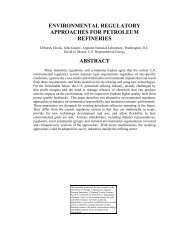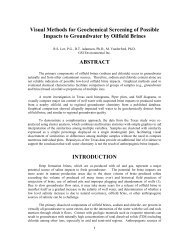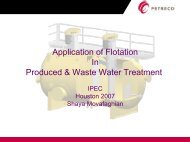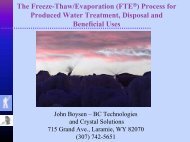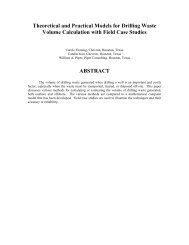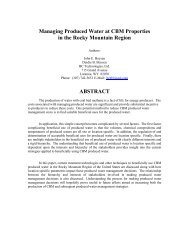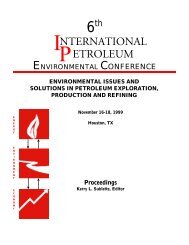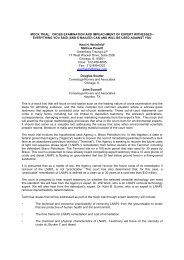Including XML Schema Tags for Production and Injection ... - IPEC
Including XML Schema Tags for Production and Injection ... - IPEC
Including XML Schema Tags for Production and Injection ... - IPEC
Create successful ePaper yourself
Turn your PDF publications into a flip-book with our unique Google optimized e-Paper software.
INCLUDING <strong>XML</strong> SCHEMA TAGS FORPRODUCTION AND INJECTION DATAREPORTING TO REGULATORY AGENCIES INTHE PIDD: A BUSINESS CASEPresented on behalf of the Ground Water Protection Council byW. Thomas Gillespie, Virtual Engineering Solutions, Inc.Deborah Gillespie, Virtual Engineering Solutions, Inc.Stan Belieu, Nebraska Oil & Gas CommissionABSTRACTState oil <strong>and</strong> gas board managers <strong>and</strong> technical staff believe that the eXtensibleMarkup Language (<strong>XML</strong>) is an ideal <strong>for</strong>mat <strong>for</strong> sharing data with oil <strong>and</strong> gas industryoperators. Two factors contribute strongly to this perception. The first factor is its lowcost in comparison with the cost of traditional electronic data interchange (EDI), which isbased on the X-12 transaction set. The second factor is the wide-scale availability of<strong>XML</strong> development tools.For all <strong>XML</strong>-enabled data transfer applications, a schema, or st<strong>and</strong>ard set ofsyntax <strong>and</strong> <strong>for</strong>matting requirements specific to the oil <strong>and</strong> gas industry, is needed as ameans of first-round of data validation. Over the past 2 years, the Ground WaterProtection Council (GWPC), a nonprofit organization dedicated to serving the oil <strong>and</strong> gasindustry through the state regulatory agencies, has coordinated the development of such aschema. The extensive development ef<strong>for</strong>t has included Technical Advisory Groupmeetings, workshops, state agency conferences, <strong>and</strong> pilot studies funded through grantsfrom the Department of Energy (DOE) <strong>and</strong> the participating states. Agencies nationwidehave embraced the schema as a st<strong>and</strong>ard. Electronic reporting initiatives are now beinglaunched in Colorado <strong>and</strong> New York <strong>and</strong> are being planned in Montana, Alaska, Utah,Mississippi, Nebraska, <strong>and</strong> Pennsylvania.The schema on which all of these applications will be based is calledeReport.xsd. Now in version 3, the eReport schema governs production, injection, <strong>and</strong>locational data. The schema itself is designed to be database-neutral, so users’ databasetable structures can remain unchanged.Because API has long written the st<strong>and</strong>ards <strong>for</strong> well construction, GWPCbelieves that API acceptance of any st<strong>and</strong>ard associated with the oil <strong>and</strong> gas exploration<strong>and</strong> development processes is both desirable <strong>and</strong> proper. GWPC there<strong>for</strong>e requested thatAPI review the schema <strong>for</strong> production <strong>and</strong> injection data reporting that it has developedthrough this collaboration of state agencies <strong>and</strong> industry volunteers <strong>and</strong> back its use. Thistopic was an agenda item at the PIDX meeting in August 2002, where meeting attendeesaccepted the eReport schema in its entirety into process <strong>for</strong> inclusion in the PIDX PIDD.
An oil <strong>and</strong> gas schema that the states have embraced <strong>and</strong> that API endorsesserves industry’s interest in the following ways:• Industry would be better able to leverage oil <strong>and</strong> gas exploration <strong>and</strong> resourcedevelopment ef<strong>for</strong>ts. Industry could produce more oil <strong>and</strong> gas more cost-effectively ifoperators had easier access to both the current <strong>and</strong> historical data warehoused inoversight agencies’ databases.• Improved data access in combination with desktop analytical tools also would behighly useful to operators in assessing production trends, risk, <strong>and</strong> other factors.• The massive ef<strong>for</strong>ts the agencies put <strong>for</strong>th to manage agency in<strong>for</strong>mation processescan be scaled back to a much more efficient <strong>and</strong> effective level, with immediatefeedback to industry as to data transfer status.This paper presents the eReport schema <strong>and</strong> discusses its tag <strong>for</strong>mat <strong>and</strong> overallstructure. A description of how the state agencies are using the schema is included, alongwith examples of how <strong>XML</strong>-<strong>for</strong>matted data exchange under the aegis of an API-approvedeReport schema would benefit all concerned parties.OIL AND GAS INDUSTRY PERSPECTIVEIn addition to filing permits <strong>for</strong> all wells drilled, produced, serviced, <strong>and</strong>ab<strong>and</strong>oned within the United States, oil <strong>and</strong> gas operators also are required to reportproduction <strong>and</strong> injection quantities <strong>and</strong> dispositions to various regulatory agencies, bothstate <strong>and</strong> federal. Some agencies require monthly reporting by lease or by well or by<strong>for</strong>mation <strong>and</strong> others require annual reporting. Each agency may have different datafields or groupings required <strong>for</strong> their particular report. Although oversight agencies insuch states as Montana, Colorado, New Mexico, <strong>and</strong> others have accepted electronictransmissions of production <strong>and</strong> injection data from operators in an ASCII <strong>for</strong>mat <strong>for</strong>several years, this procedure, like the manual data collection systems still in use, has beenfraught with errors because of the inability to validate data easily, leading to excessiveiterations <strong>for</strong> corrections <strong>and</strong> manual data checks on the parts of both industry <strong>and</strong>agencies.From the industry viewpoint, with millions of oil <strong>and</strong> gas wells nationwide,providing this in<strong>for</strong>mation through iterative, manual methods is a financial <strong>and</strong>administrative burden. Particularly <strong>for</strong> small- to mid-sized <strong>and</strong> independent operators,preparing production reports often involves several <strong>for</strong>mat changes as data from onesystem is re-keyed or converted into another. In addition, the data reported—data thatmay be a part of the public record—remains difficult to access in agency datarepositories.The Internet <strong>for</strong>mat known as <strong>XML</strong> has made data exchange tools available tothe small- <strong>and</strong> medium-sized companies where previously only the largest companiescould meet the capital investment needed to effectively use EDI. Many tools are nowavailable to generate, validate, <strong>and</strong> accept <strong>XML</strong>-<strong>for</strong>matted data into receiving databases.Because of this combination of factors—the significantly reduced cost of operating an
<strong>XML</strong> data exchange system <strong>and</strong> the plethora of available <strong>XML</strong> development tools—the<strong>for</strong>mat is ideal <strong>for</strong> state agencies with severely restricted budgets. <strong>XML</strong> is an idealmethod <strong>for</strong> sharing in<strong>for</strong>mation between loosely coupled systems. A schema, or st<strong>and</strong>ardset of syntax <strong>and</strong> <strong>for</strong>matting requirements specific to the oil <strong>and</strong> gas industry, is needed asa first-round means of data validation in <strong>XML</strong>-based data exchange applications.An oil <strong>and</strong> gas schema approved by API would have greater utility <strong>and</strong>applicability beyond the purposes of only the regulatory agencies. Indeed, agencies,industry operators, <strong>and</strong> other interested parties will reap significant benefits from parsingdata transfers against an Internet-based oil <strong>and</strong> gas schema. A few examples follow:• Administrative delays would be reduced because data validation would be automated.• Operators would receive immediate feedback as to data transfer status.• Wide-scale production data would become readily accessible to industry.• Software developers could write data-driven applications that are built around theschema.• Trading partners could readily exchange data.• Purchasers <strong>and</strong> transporters could use the schema to provide data to operators.• Industry owners who operate across state boundaries could report to multiple stateregulatory agencies in one st<strong>and</strong>ard <strong>for</strong>mat, reducing the need to customize theirproduction reports to con<strong>for</strong>m to agency-specific <strong>for</strong>matting particularities.Because API has long written the st<strong>and</strong>ards <strong>for</strong> well construction, GWPCbelieves that API acceptance of any st<strong>and</strong>ard associated with the oil <strong>and</strong> gas exploration<strong>and</strong> development processes is both desirable <strong>and</strong> proper. GWPC there<strong>for</strong>e requested thatAPI review the schema that it has developed with the assistance of multiple states <strong>for</strong>production <strong>and</strong> injection data reporting <strong>and</strong> back its use as a st<strong>and</strong>ard <strong>for</strong> the oil industryThis topic was an agenda item at the PIDX meeting in August 2002, where meetingattendees accepted the eReport schema in its entirety <strong>and</strong> without amendment <strong>for</strong>inclusion in the PIDD.THE BUSINESS ISSUEOne of the primary benefits that would accrue to industry from improved dataaccess is the ability to leverage oil <strong>and</strong> gas exploration <strong>and</strong> resource development ef<strong>for</strong>ts.Industry could produce more oil <strong>and</strong> gas more cost-effectively if operators had access toboth the current <strong>and</strong> historical data warehoused in oversight agencies’ databases. Dataaccess in combination with desktop analytical tools also would be highly useful tooperators in assessing the risks of their operations. An API-recognized schema <strong>for</strong> oil <strong>and</strong>gas production <strong>and</strong> injection reporting would be the first step in providing consistent <strong>and</strong>bi-directional data exchange between agencies <strong>and</strong> operators.The dual goals of cutting the cost of oil exploration ef<strong>for</strong>ts while boostingresource output are not the only possible benefits that would accrue to industry with theadoption of a schema. A schema would make it possible to share data reporting <strong>and</strong>interpretation tools <strong>and</strong> other features across disparate database systems.For example, data could be downloaded from multiple state databases <strong>and</strong> usedwith geographical in<strong>for</strong>mation system (GIS) tools so that industry can obtain a clearer
picture of production trends, risk, <strong>and</strong> other factors across state boundaries withoutrequiring changes to anyone’s database table structure.Industry owners whose operations transcend state boundaries would have theirreporting requirements simplified under a st<strong>and</strong>ard schema because data <strong>for</strong>matting <strong>and</strong>syntax <strong>for</strong> data transfers would be uni<strong>for</strong>m nationwide. Data transfers would be parsedagainst this st<strong>and</strong>ard schema as a first-round data validation check. Second-round datachecks, which would be imposed at agencies’ Web servers as stored procedures, maydiffer across boundaries because of statute-imposed differences. However, variations inthese second-round checks would be h<strong>and</strong>led by each agency’s Web application userinterface <strong>and</strong> would remain largely transparent to industry operators, who would receiveimmediate feedback as to data transfer status through the browser.Sharing data resources can be enormously profitable, both <strong>for</strong> the oil <strong>and</strong> gasoperators charged with developing the resource while safeguarding the environment <strong>and</strong><strong>for</strong> the oversight agencies in their role of analyzing risk <strong>and</strong> reporting trends. For bothparties, <strong>XML</strong>-<strong>for</strong>matted data exchange under the aegis of an API-approved schemarepresents a savings in the elimination of iterative medium changes during data transfer<strong>and</strong> reduced costs in data analysis. Automating first-round data checks of electronicallytransferred data through a schema <strong>and</strong> then instituting agency-specific second-roundchecks through stored procedures at the database server means that the data will beavailable <strong>for</strong> download from the same database server more quickly.Use of a schema offers vast efficiencies over either of the procedures now inuse—paper submittals with manual validation <strong>and</strong> ASCII delimited transfers with manualvalidation—<strong>and</strong> will yield substantial cost <strong>and</strong> time savings that could be plowed backinto resource development. With the ability to evaluate production <strong>and</strong> injection dataacross leases <strong>and</strong> other boundaries, industry could put more ef<strong>for</strong>t into developing <strong>and</strong>managing the resource responsibly. Meanwhile, the massive ef<strong>for</strong>ts the agencies put <strong>for</strong>thto manage in<strong>for</strong>mation processes can be scaled back to a much more efficient <strong>and</strong>tremendously more effective level. The business flow <strong>for</strong> such a reporting system isshown in Figure 1.ABOUT THE eREPORT SCHEMADEVELOPMENTGWPC is a nonprofit (501(c)3) organization whose members consist of state <strong>and</strong>federal ground water agencies, industry representatives, <strong>and</strong> others, who work toward theprotection of the nation’s ground water supplies. In 1992, under grant fundingadministered to by the DOE, GWPC began coordinating the development of the RiskBased Data Management System (RBDMS) now in use by oil <strong>and</strong> gas agencies acrossthe nation to track well-related activities. In 2001, GWPC received an Energy 100 awardthat recognized RBDMS as one of the 100 best scientific <strong>and</strong> technologicalaccomplishments since the DOE's creation in 1977.GWPC has continued its tradition of excellence in software support <strong>for</strong> the oil<strong>and</strong> gas industry <strong>and</strong> source water protection agencies through the development of theEnvironmental In<strong>for</strong>mation Management Suite (EIMS). EIMS is GWPC’s strategic
approach to assist states <strong>and</strong> industry in managing in<strong>for</strong>mation about oil <strong>and</strong> gasproduction wells, underground injection wells, source water, <strong>and</strong> watersheds. EIMSoffers flexible integration of customizable data management tools including RBDMS, aSource Water database to support Source Water Assessment Programs, <strong>and</strong> tools such aswellbore schematic utilities, multilateral well construction tracking, Internet reporting,online GIS applications, <strong>and</strong> more. GWPC is interested in making these EIMS tools <strong>and</strong>the necessary technical support available to those parties who want them nationwide (seeFigure 2).In the last 2 years, GWPC <strong>and</strong> the oil- <strong>and</strong> gas-producing state agenciesnationwide have worked to develop a schema <strong>for</strong> oil <strong>and</strong> gas production <strong>and</strong> injectionreporting that could be used with Web-enabled databases. The schema itself is designedto be database-neutral, so that users do not need to change their table structures. Thanksto the dedication of the Technical Advisory Group members <strong>and</strong> the participating stateagencies, such electronic reporting initiatives are now being launched in Colorado <strong>and</strong>New York <strong>and</strong> are being planned in Montana, Alaska, Utah, Mississippi, <strong>and</strong>Pennsylvania. All of these installations are or will be based on the oil <strong>and</strong> gas schemadeveloped <strong>for</strong> this purpose, which is now called eReport.xsd.Now in version 3, the eReport schema was developed through extensive reviewsof W3C st<strong>and</strong>ards, the PIDX PIDD, <strong>and</strong> the regulatory requirements <strong>and</strong> business rules ofthe participating agencies. The GWPC’s Technical Advisory Group, comprising ITmanagers <strong>and</strong> database administrators <strong>for</strong> oversight agencies nationwide, participated inthe development <strong>and</strong> review of the eReport.xsd through meetings <strong>and</strong> workshops. Grantfunding from the DOE <strong>and</strong> participating state agencies has been made available to launchpilot studies to test the results, which have been highly successful. Industry operators inNew York have praised the process streamlining that has resulted from using applicationsthat reference the eReport.xsd to transfer data to agencies. At this time, the Colorado Oil<strong>and</strong> Gas Conservation Commission is proceeding with testing the use of <strong>XML</strong> filetransfers from oil <strong>and</strong> gas industry databases as an integral component of well reportingactivities <strong>and</strong> plans to roll out the application soon.GWPC solicited API’s review at this point in the development process, <strong>and</strong> APIconcurred with the opinion that incorporating these schema tags into the PIDD will havefar-reaching benefit <strong>for</strong> all concerned parties. The state agencies that GWPC representswill continue to build on this schema <strong>for</strong> other aspects of oil <strong>and</strong> gas reporting <strong>and</strong>permitting <strong>and</strong> welcome the collaboration of agency volunteers.STRUCTURE OF THE SCHEMAAs shown in Figures 3 <strong>and</strong> 4, the content model <strong>for</strong> the eReport oil <strong>and</strong> gasschema is based on a flat catalog of all acceptable elements in an <strong>XML</strong>-<strong>for</strong>matted transferof production <strong>and</strong> underground injection control (UIC) data into states’ primary oil <strong>and</strong>gas database. The schema is based on the root element eReport, which has only onesubordinate global element, Company.In addition to simple elements to identify company addresses <strong>and</strong> telephonenumbers, the Company global element includes another critical global element, Facility.A facility can be a single well, a lease, a unit, a tank farm, or any other method of
grouping oil, gas, <strong>and</strong> UIC structures <strong>and</strong> entities. There<strong>for</strong>e, this schema can be used toreport production <strong>and</strong> UIC data in a <strong>for</strong>mat that matches the targeted agency’s m<strong>and</strong>atedmethods <strong>for</strong> reporting. For maximum flexibility, two levels of the FacilitiesType globalelement have been defined in the schema. The same data elements associated with thetop-level FacilitiesType are repeated in a subordinate Facility global element. Stateagencies may wish to use both levels of Facilities, if <strong>for</strong> example, data is collected bothby lease <strong>and</strong> by well.The schema itself is shown in at the end of this technical paper. Although eachagency will institute its own second-round data validation checks as stored procedures oneach Web server, the schema itself imposes <strong>for</strong>matting <strong>and</strong> syntax requirements on allfields included in data transfers <strong>and</strong> requires that three fields in particular be present in alldata transfers to pass first-round checks:• CompanyID• First-level FacilityID• First-level FacReportingPeriodFUTURE DEVELOPMENT AND VERSIONCONTROLAlthough version 3 of the schema covers production, injection, <strong>and</strong> locationaldata, the participating agencies are interested in exp<strong>and</strong>ing the schema to coverpermitting issues. This schema expansion will be developed through the same open,cooperative ef<strong>for</strong>t that has characterized the schema development process to date. TheGWPC <strong>and</strong> partnering state agencies actively encourage the participation of API, PIDX,<strong>and</strong> REGS representatives in this process.The life cycle of a well, from a regulatory perspective, could easily exist in asingle schema. To meet the accelerated development schedule dem<strong>and</strong>ed by government<strong>and</strong> industry, a process unhindered by bureaucracy must be put into place to namest<strong>and</strong>ards. The ideal medium to document future schema changes <strong>and</strong> additions may bethe PIDD, which could exist on API’s Web site <strong>for</strong> universal access. GWPC <strong>and</strong> the stateagencies would particularly welcome API’s inclusion of the eReport schema tagsdeveloped to date in the PIDD. Columns could be added to the PIDD to reflect thefollowing:• <strong>XML</strong> tag name• Data type• Occurrences• Restrictions• Namespace• Parent TypeIf API assigned one of its employees to manage PIDD changes, additions <strong>and</strong>revisions could be submitted to that individual <strong>and</strong> posted after review <strong>for</strong> conflicts. Thiswould ensure neutrality <strong>and</strong> timeliness of updates.
The state agencies fully expect that the eReport schema will continue to bedeveloped into the future to cover other oil- <strong>and</strong> gas-related functions. Both GWPC <strong>and</strong>the agencies look <strong>for</strong>ward to API’s review comments <strong>and</strong> active participation in theprocess.STATE AGENCY USE OF THE SCHEMAAs mentioned previously, state agencies are in the process of implementingInternet-based production <strong>and</strong> injection reporting applications. Although the applicationsthat accept the data transfers differ from state to state, they use a common schema: theeReport.xsd discussed in this paper. Since the <strong>XML</strong> data transfers are parsed against theschema, any <strong>XML</strong> file submitted to one of these agencies must reference the schemauniversal resource locator in the file namespace <strong>and</strong> the reported data must con<strong>for</strong>m tothe syntax rules described within the schema.Compliance with the schema requirements moves the data into the next phase ofintegrity checks at the agency server. However, a data transfer that fails to con<strong>for</strong>m to the<strong>for</strong>mat <strong>and</strong> syntax will cause the parser to stop processing <strong>and</strong> the data transfer to berejected. The generic data flow in the <strong>XML</strong> transfer to the agencies is shown in Figure 5.The oversight agencies will import <strong>XML</strong> data transfers from industryrepresentatives into a database structure that contains tables corresponding to the parentelements in the schema. This entity relationship diagram is shown in Figure 6. The tablesin the data structure are named 'tbl<strong>XML</strong>' followed by the schema parent element name.An ActiveX .dll developed <strong>for</strong> this purpose reads the <strong>XML</strong> data <strong>and</strong> stores thein<strong>for</strong>mation in a database.Second-round data checks, which are imposed at the agencies’ Web servers asstored procedures, also differ across boundaries because of statute-imposed differences.However, variations in these second-round checks are h<strong>and</strong>led by each agency’s Webapplication user interface <strong>and</strong> will remain largely transparent to industry operators, whowould receive immediate feedback as to data transfer status through the browser. Forexample, some of the second-round data validations being used in the Colorado eReportWeb application follow:• Codes, IDs, <strong>and</strong> API well numbers must be valid.• If a value is reported <strong>for</strong> injection, the casing <strong>and</strong> tubing pressure must be reported.• If a sold value is present, then the quality (specific gravity or BTU) must be reported.• Specific gravity must be a value between 5 <strong>and</strong> 80.• All numbers must be whole numbers except specific gravity.• The number of days producing should not exceed those in the month.Other states may choose to use other data validations or to activate other schematags as being required fields.
SUMMARY: BUSINESS BENEFITS OF AN API-APPROVED SCHEMAThe widespread utility of the current eReport schema in st<strong>and</strong>ardizing data field<strong>for</strong>matting <strong>and</strong> syntax requirements <strong>for</strong> production <strong>and</strong> injection reporting among theagencies nationwide also demonstrates three genuinely valuable opportunities <strong>for</strong> the oil<strong>and</strong> gas industry at large:• The schema makes use of improved technology to simplify data transfer <strong>and</strong>automate validation processes, thus eliminating administrative layers of re-keying<strong>and</strong> manual review cycles.• Feedback as to data transfer status is immediate, thus eliminating the delays thatindustry experiences as a result of agency rework loops.• Data transfer between industry <strong>and</strong> agencies can become bi-directional. Improveddata access by industry would greatly leverage exploration <strong>and</strong> resource developmentef<strong>for</strong>ts by facilitating production trend analysis across lease, state, federal, <strong>and</strong> otherboundaries.From the start, the process to develop the schema has been an open, cooperativeprocess that has involved multiple state agencies <strong>and</strong> has been funded through DOE grant<strong>and</strong> matching state funds administered by the GWPC. Volunteers from industry are nowproviding testing <strong>and</strong> feedback <strong>and</strong> will be tapped to participate in the review group thatwill oversee continued development. The PIDX committee members’ acceptance of theeReport schema tags <strong>for</strong> use in reporting production <strong>and</strong> injection data indicatesagreement with GWPC <strong>and</strong> partnering states on the viability of this method of bridgingthe data management needs of both industry <strong>and</strong> oversight agencies.On behalf of GWPC, the schema is now being hosted at the following URL:http://VirtualES.com/xml/eReport.xsd. Data element occurrence <strong>and</strong> <strong>for</strong>matting can bereviewed at http://virtuales.com/xml/<strong>Schema</strong>Ver3Doc/eReport_ver3.html.
Operator creates<strong>XML</strong> file via Web<strong>for</strong>m or databaseexportFile transferred to agencyvia Web <strong>for</strong>m or POP 3mail message attachmentPrimaryedit <strong>for</strong>acceptanceYesParsedintoTemporaryStorageNoError <strong>and</strong> technical correctionAgencyProcessed <strong>for</strong>DetailedTechnicalAcceptanceApproval returned to operatorAcceptedintoAgencyDatabaseFigure 1. Process Flow <strong>for</strong> eReporting Oil <strong>and</strong> Gas Data to Oversight Agencies. Industryoperators could report production <strong>and</strong> injection data directly to agency databases via theInternet. The data transfer file would include a reference to the st<strong>and</strong>ard oil <strong>and</strong> gasschema. The data would be instantaneously parsed against the schema as a first-roundprimary data validation check. Status would be returned to the user’s browser.
Figure 2. EIMS Software Installations Nationwide. GWPC’s EIMS software isdeveloped <strong>and</strong> tested through the active participation of the state agencies it represents,thus ensuring the software’s compatibility with the agency requirements nationwide.
Figure 3. The eReport <strong>Schema</strong> Structure. In addition to imposing <strong>for</strong>matting <strong>and</strong> syntaxrequirements <strong>for</strong> all fields, the schema m<strong>and</strong>ates three required fields <strong>for</strong> a data transferto pass first-round data checks: CompanyID, first-level FacilityID, <strong>and</strong> first-levelFacReportingPeriod elements. Agencies have the flexibility to activate other elementsthrough second-round data validations. See Figure 4 <strong>for</strong> an exp<strong>and</strong>ed view of the Facilityelement.
Figure 4. eReport <strong>Schema</strong> Facility Element. The same data elements associated with the top-levelFacilitiesType are repeated in a subordinate Facility global element. State agencies may wish to useboth levels of Facilities, if, <strong>for</strong> example, data is collected both by lease <strong>and</strong> by well.
eReport(<strong>XML</strong>transfer)LocalDatabaseQueryOil & GasIndustryUsersSecureWebServer<strong>Schema</strong> Compliance?Data Validated?Data OK/Data Not OKWeb ServerDatabaseFirewallNotice of Data Transfer Status(Pass/Fail with Reason)On QC Pass/ReplicationStateAgencyDatabaseFigure 5. <strong>XML</strong> Data Flow <strong>for</strong> Uploading eReport Submittals to Agency Databases. The results oflocal database queries are uploaded from industry databases in eReport schema-compliant <strong>XML</strong> files.Files that are successfully parsed against the schema are passed to the second-round validation checksat the database server. Status messages (pass/fail) are returned to the user’s browser within seconds ofupload.
Figure 6. Complementary Entity Relationship Diagram <strong>for</strong> the eReport.xsd. Any custom databaseapplications designed <strong>for</strong> industry use in creating eReport schema-compliant <strong>XML</strong> files must includethese tables to function successfully.
THE eREPORT SCHEMA- - - Oil <strong>and</strong> gas production <strong>and</strong> UIC reporting <strong>for</strong> state regulatoryagencies. Version 3- - - - Location coordinates <strong>and</strong> metadata- - - Location section.- - Location township.- - Location township direction.- - Location range.- - Location range direction.-
- Location quarter quarter.- - Location town.- - - - Location meridian.- - Location method (GPS, Map, Survey).- - Location latitude.- - Location longitude.- - Location datum.- - Location UTM X coordinate.- - Location UTM Y coordinate.
- - Location UTM zone.- - API state code.- - API county code.- - Tax map <strong>and</strong>/or parcel number. Also known as section block<strong>and</strong> lot.- - Name, address, <strong>and</strong> phone number ofoperator- - - Unique ID <strong>for</strong> this company.- - Name of this company.- - - - Company street number.-
- - Company street name.- - - Company street direction.- - - - Name of the city where the company islocated.- - - State in which the company is located.- - - - Company zip code.- -
- - Company zip code extension ("plus 4").- - - - Company telephone number.- - - - Company fax number.- - - - In<strong>for</strong>mation on tanks/storage facilities- - - Unique ID <strong>for</strong> tank at this facility.- -
- - Capacity of tank in barrels.- - - - Volume of fluid pad held in tank.- - - - Type of fluid held in tank.- - - - Date tank was installed. Use yyyy-01-01 if exact date isunknown.- - Description of tank.- - -
- Tank type.- - - - Tank construction.- - - - Tank base.- - - - Data on fluids/gas produced from a well <strong>and</strong>purchases- - - Oil, gas, water produced or other fluid. St<strong>and</strong>ard codesneeded.- - -
- Beginning fluid inventory.- - Ending fluid inventory.- - Units used to report quantities of fluid produced ortransferred.- - - - Quantity produced.- - Maximum daily quantity of fluid produced.- - Duration of producing period in days.- - Average daily fluid production.- - Description of or comments aboutproduction.- - Fluid disposition data.
- - - - Code to indicate how the fluid was was exported. For examplesold, flared, injected, etc.- - Quantity of fluid transferred.- - ID <strong>for</strong> pit, injection well, or other destinationlocation.- - ID <strong>for</strong> sales transporter.- - - - ID <strong>for</strong> this purchaser.- - - - Date of sale.- - BTU rating of gas.
- - Specific gravity of oil involved in this sale.- - Dollar value of fluid at well head.- - <strong>Injection</strong> pressures <strong>and</strong> volumes- - - <strong>Injection</strong> type (water, CO2, etc.)- - Cumulative fluid injection.- - Quantity injected.- - Maximum daily quantity injected.- - Units of injectate.- - Days in period that injection occurred.
- - <strong>Injection</strong> pressures. Multiple locations can be used byspecifying different location values- - - - Location of injection pressure measurement (casing, tube,manifold).- - - - Average injection pressure at this location.- - Maximum injection pressure at thislocation.- - Date <strong>and</strong> time that injection pressure wasread- - Facility in<strong>for</strong>mation on one level- - -
Unique ID <strong>for</strong> this facility.- - - - <strong>Production</strong> period <strong>for</strong> the facility. For monthly reporting,<strong>for</strong>mat will be mm/yyyy. For annual reporting, <strong>for</strong>mat will beyyyy.- - - - If true, correction of previously submitteddata.- - Code to indicate if this is a well, lease, or facility (well leasefacility).- - - - Status of facility/well such as 'A' active or 'PA' plugged <strong>and</strong>ab<strong>and</strong>oned.- - Operator unique ID (serial number) <strong>for</strong> thisfacility
- - Description of facility.- - Method of production- - Meter ID, if appropriate.- - - - Producing <strong>for</strong>mation.- - - - Name of facility, lease, or well. Depends on how wells aregrouped.- - - - Name of the producing field.- -
- - Group that this facility belongs to. For example a unit name <strong>for</strong>a well.- - Facility in<strong>for</strong>mation recursed (i.e. facility, subset of facility(well))- - - - - - - Code to indicate inventory item. For example 'PR' <strong>for</strong> producingwells- - Quantity/count of this item (well type,etc.)



